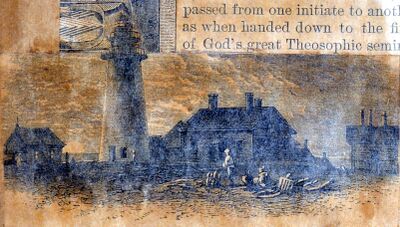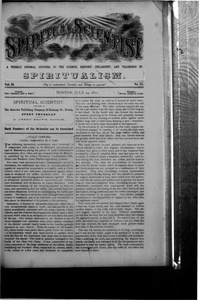 |
From C. Sotheran's Percy Bysshe Shelly.
<Untitled> (A great traveler, and most larned modern writer)A great traveler, and most larned modern writer ... |
 |

Lively Coffins
The following mysterious occurrences were witnessed in connection with a tomb in St. Michael’s churchyard. Island of Barbadoes, during the period of Lord Combermere’s Government, 1817—1820, and are extracted from his Memoirs as published by his widow, Vicountess Combermere, 1866. (Hurst and Blackett, Great Marlborough-street, London.)
For some time previous to Lord Combermere s arrival in Barbadoes, the inhabitants had been at intervals startled by reports of mysterious occurrences in a family vault at Christ Church, where It was said some supernatural agency always upset or displaced the coffins deposited there. No negro would approach the burying-ground towards nightfall. Women whispered wonderful stories of apparitions, and children were threatened with its horrors to insure obedience. Lord Combermere, bearing of the terror occasioned by these rumors, and ascertaining that the coffins had actually been several times displaced, resolved on investigating the matter personally. The family to whom the vault belonged were anxious to have it examined; and as an interment was immediately to take place, he determined to be present at the ceremony.
Barbadoes is formed of calcareous rock over which lies a very inconsiderable depth of earth; but that portion of the island immediately connected with our story,—namely, Christ Church, and the adjacent burying-ground, stands upon a shelf of coral which rises to an eminence of 1oo feet above the level of the sea. The church dedicated to our Saviour is one of eleven founded two centuries since, when various members of the district erected family vaults in the burying grounds appointed to each church. From the nature of the foundation, these tombs were partly above, partly below the surface, —a circumstance which may have served to protect them from the fury of the hurricanes that from time to time have devasted the island. The vault in question belonged to the family of the Hon. Col. Chase. It was constructed of masonry composed of the large sandstone of the island, closely resembling our Portland stone, connected by cement, which, in the course of s few years, had hardened so completely as to render the walls as solid as if formed of entire stone. The roof and flooring were constructed in the same way and of the same materials. The sides inclining towards the top, left the roof smaller than the base, which was 12 feet long by 6 feet broad. In the fourth side was formed the doorway the masonry projecting at the bottom, and gradually decreasing towards the top, forming an inclined plane against which rested a large slab of solid stone, forming a door; immediately inside two or more steps descended to the basement.
On the occasion of an interment in this vault, August 9th, 1812, those engaged in opening it to receive the body were astonished to find that two of the large leaden coffins had been removed from their places. One was thrown over on the ground, while that of an infant had been pitched from one side to the opposite corner.
The black laborers became alarmed, and hastened to the church officials to relate this singular circumstance; but no credence was given to their story, and it was imagined that, actuated by a love of mischief, these men had upon the last occasion, in order to create a sensation, entered the vault before closing the door, disturbed the coffins, and left them in this disorder. Vain were the protestations of innocence; and even the known horror which all negroes attach to death and burial-places was not accepted as a confirmation of their assertions. They were accordingly severely reprimanded, and the church officials, fearing lest they should be censured for neglect, determined to keep strict watch over this particular vault for the future, and endeavored to prevent the knowledge of what had transpired from circulating beyond those immediately concerned; they consequently acted with the greatest caution at the-closing of the door alter the burial had taken place, having previously seen the coffins rearranged, and the vault restored to its usual order. They further satisfied themselves of the impossibility of ingress by any other than the legitimate means.
Four years and two months had elapsed when Death again visited the Chase family, and the vault destined to receive another inmate,—a tiny coffin and its baby tenant The officials eagerly repaired to the spot. External examination proved that the door had not been disturbed since last dosed. All appeared exactly as they left it. No crack in any of the walls warranted any suspicion of violence, and yet, when the door was removed, the vault displaped much greater confusion than on the previous occasion.
This was too serious an occurrence to be long overlooked, and it was felt the family ought to be apprised of it, and the perpetrators of the trick discovered, if possible, and punished. After examining the vault, and questioning the masons very closely, the family now informed of all the circumstances were disposed to treat the matter lightly. The vault consequently was re-arranged and closed, after the coffin of the infant had been deposited there.
<... continues on page 3-252 >
Editor's notes
Sources
-
Spiritual Scientist, v. 2, No. 21, July 29, 1875, pp. 241-2

